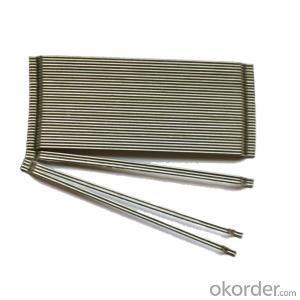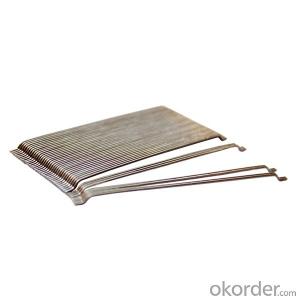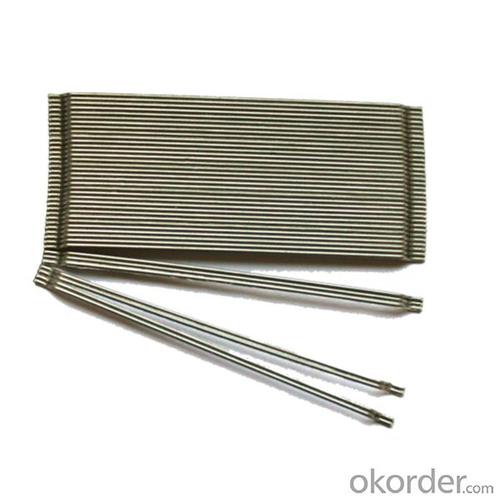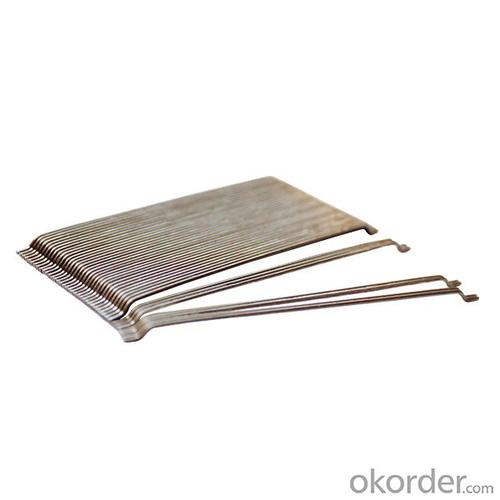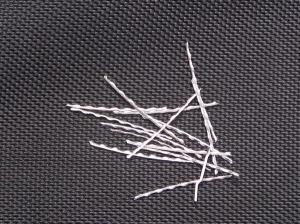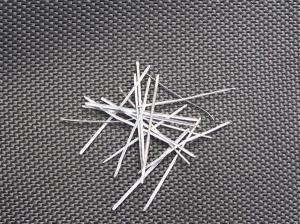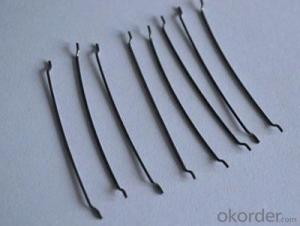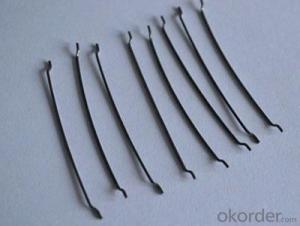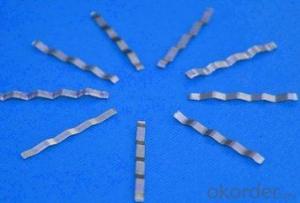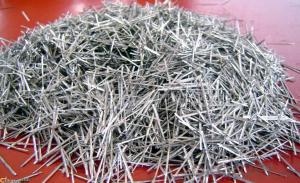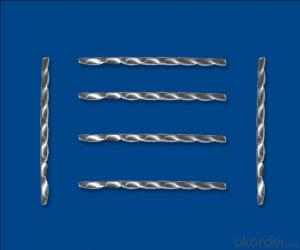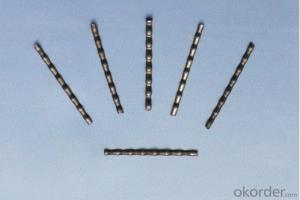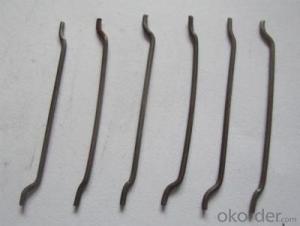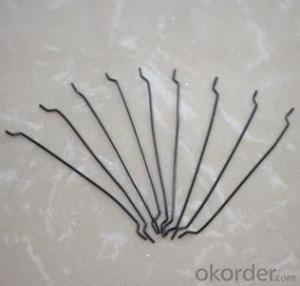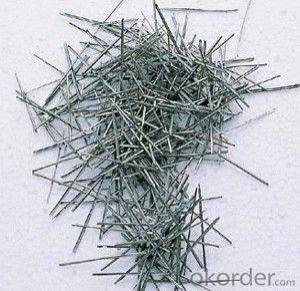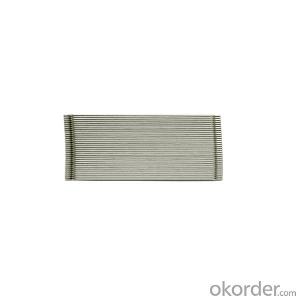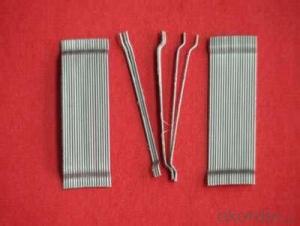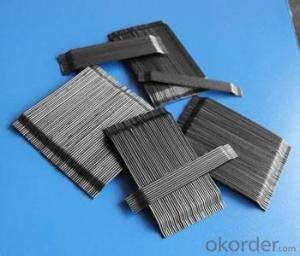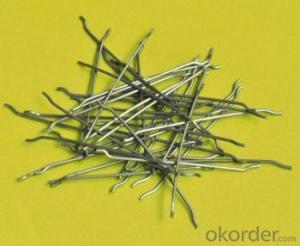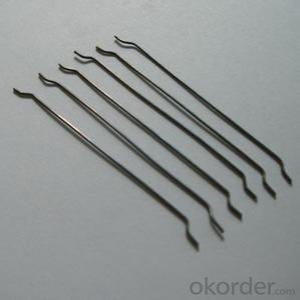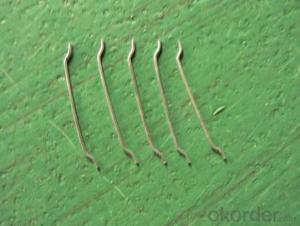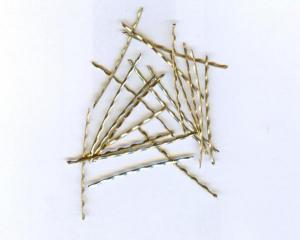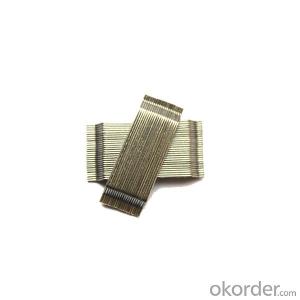Melt Extract Stainless Steel Fiber Cement Price Constructions Steel Fiber CNBM
- Loading Port:
- Tianjin
- Payment Terms:
- TT OR LC
- Min Order Qty:
- 1 m.t.
- Supply Capability:
- 600 m.t./month
OKorder Service Pledge
Quality Product, Order Online Tracking, Timely Delivery
OKorder Financial Service
Credit Rating, Credit Services, Credit Purchasing
You Might Also Like
Quick Details
Place of Origin: Tianjin, China (Mainland)
- Model Number: 0.55
Material: Steel
Production Process: Cold drawn
Fiber Lengh: 35
Type: 1
Compressive Strength: >1200MPa
Aspect ratio: 63
Standard: ASTM A820M-11
Section Shape: Circular
Application: Concrete Reinforcement
- Product Application: Industrial Floor
Packaging & Delivery
| Packaging Details: | 20 kg/Bag,50 bags/Pallet or 1,000kg/ Bulk Bag |
|---|---|
| Delivery Detail: | 1 Month |
Product Description
| Diameter | 0.55 | mm | 0.02 | in |
| Length | 35.00 | mm | 1.37 | in |
| Aspect Ratio | 64 | |||
| Tensile strength | 1200 MPa | |||
| Type | Cold drawn Steel Fiber | |||
| End | Hooked-end Steel Fiber | |||
| Glued/Loose | Glued Steel Fiber | |||
| Bending Angle | 45°(min.30°) | |||
| Usage & Performance | Floor:Trafficked areas and Industrial floors | |||
| Shotcrete :Slope stabilization and Final lining | ||||
| Precast concrete:Pipe and Railway sleepers | ||||
| Packing | Standard Export Pallet Packing | Bag Packing | 20 kg/Bag,50 bags/Pallet | |
| Bulk Packing | 1,000kg/ Bulk Bag | |||
| Loading Quantity | 20’GP | 20-25 Tonne/Tonnes | ||
| 40’GP | 25-27 Tonne/Tonnes | |||
| 40’HQ | 25-27 Tonne/Tonnes | |||
| MOQ | 1 kg for trial order | |||
| Supply Ability | 10,000 Tonne/Tonnes per Year | |||
| Payment Terms | T/T or L/C at sight | |||
| Delivery Time | Within 15 days after receiving deposit or original L/C at sight | |||
| Certification | ISO9001:2000, CE, | |||
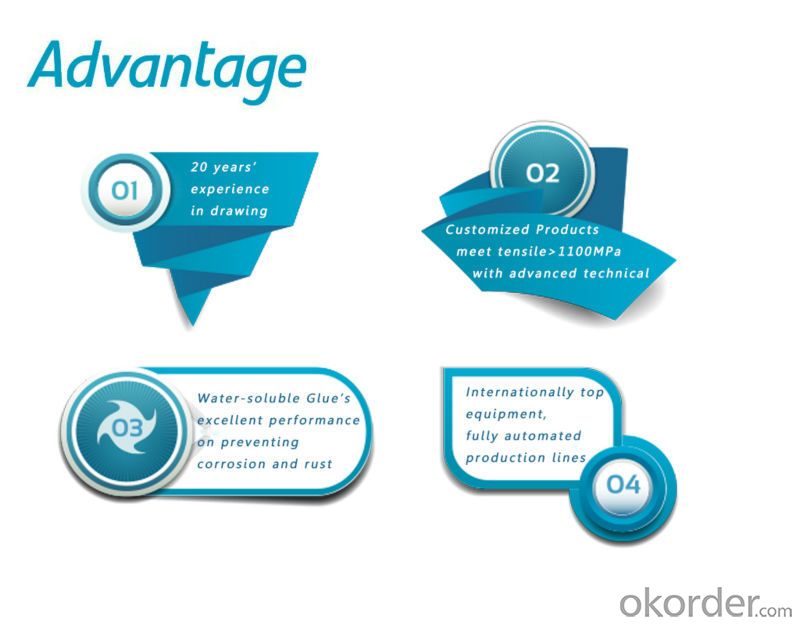
| Product | Diameter | Length mm/in | Aspect Ratio | Type | Packing |
| G-6030 | 0.5 mm (0.0197 in) | 30 mm (1.1811 in) | 60 | Glued | 20 kg/Bag, or 1,000kg/ Bulk Bag |
| G-6535 | 0.55 mm (0.0217 in) | 35 mm (1.3780 in) | 65 | Glued | 20 kg/Bag, or 1,000kg/ Bulk Bag |
| G-6035 | 0.6 mm (0.0236 in) | 35 mm (1.3780 in) | 60 | Glued | 20 kg/Bag, or 1,000kg/ Bulk Bag |
| G-8060 | 0.75 mm (0.0295 in) | 60 mm (2.3622 in) | 80 | Glued | 20 kg/Bag, 50 bags/Pallet |
| G-6060 | 0.9 mm (0.0354 in) | 60 mm (2.3622 in) | 60 | Glued | 20 kg/Bag, 50 bags/Pallet |
| G-6030 | 0.5 mm (0.0197 in) | 30 mm (1.1811 in) | 60 | Loose | 20 kg/Bag, or 1,000kg/ Bulk Bag |
| G-6535 | 0.55 mm (0.0217 in) | 35 mm (1.3780 in) | 65 | Loose | 20 kg/Bag, or 1,000kg/ Bulk Bag |
| G-6035 | 0.6 mm (0.0236 in) | 35 mm (1.3780 in) | 60 | Loose | 20 kg/Bag, or 1,000kg/ Bulk Bag |
| G-8060 | 0.75 mm (0.0295 in) | 60 mm (2.3622 in) | 80 | Loose | 20 kg/Bag, 50 bags/Pallet |
| G-6060 | 0.9 mm (0.0354 in) | 60 mm (2.3622 in) | 60 | Loose | 20 kg/Bag, 50 bags/Pallet |
- Q: Is melt extract stainless steel fiber compatible with all types of admixtures?
- No, melt extract stainless steel fiber may not be compatible with all types of admixtures. Compatibility depends on the specific type of admixture and its chemical composition, as well as the intended application. It is important to consult with experts or manufacturers to determine the compatibility before usage.
- Q: What are the advantages of using melt extract stainless steel fiber in shotcrete applications?
- There are several advantages of using melt extract stainless steel fiber in shotcrete applications. Firstly, melt extract stainless steel fiber enhances the overall durability and strength of shotcrete. The fibers act as reinforcement, providing additional tensile strength to the material. This is especially important in shotcrete applications where the material is subjected to high levels of stress or impact. Secondly, using stainless steel fiber in shotcrete increases the resistance to cracking and shrinkage. The fibers help to distribute stress more evenly throughout the material, reducing the likelihood of cracks forming. This is particularly beneficial in shotcrete applications where the material needs to withstand harsh environmental conditions or heavy loads. Additionally, melt extract stainless steel fiber improves the overall resistance to corrosion. Stainless steel is known for its excellent corrosion resistance properties, making it an ideal choice for shotcrete applications exposed to aggressive environments, such as marine structures or chemical plants. Furthermore, the use of stainless steel fiber in shotcrete can help to increase the lifespan of the structure. By reducing cracking and improving durability, the material becomes more resistant to deterioration over time. This can result in significant cost savings in terms of maintenance and repair. Lastly, melt extract stainless steel fiber offers ease of application. The fibers can be easily mixed into the shotcrete mixture, allowing for a seamless integration into the construction process. This simplifies the overall installation process and reduces the need for additional reinforcement methods. In conclusion, the advantages of using melt extract stainless steel fiber in shotcrete applications include enhanced durability, increased resistance to cracking and corrosion, improved lifespan of the structure, and ease of application. These benefits make it a preferred choice for various shotcrete projects, providing long-term performance and cost-effectiveness.
- Q: Can melt extract stainless steel fiber be used in highway pavements?
- Yes, melt extract stainless steel fiber can be used in highway pavements. Stainless steel fibers are known for their high strength and durability, making them suitable for withstanding heavy traffic loads and harsh environmental conditions. When added to concrete or asphalt mixtures, stainless steel fibers enhance the overall performance of the pavement by improving its crack resistance, flexural strength, and fatigue resistance. This helps to extend the lifespan of the pavement and reduce the need for frequent repairs and maintenance. Additionally, the corrosion-resistant nature of stainless steel fibers ensures that the highway pavement remains intact and structurally sound over time. Therefore, the use of melt extract stainless steel fiber in highway pavements is a viable solution for enhancing their durability and longevity.
- Q: What is the lifespan of concrete reinforced with melt extract stainless steel fiber?
- The lifespan of concrete reinforced with melt extract stainless steel fiber can vary depending on various factors such as the quality of the concrete mix, the environmental conditions it is exposed to, and the maintenance practices followed. However, on average, this type of reinforcement can significantly extend the lifespan of concrete compared to traditional reinforcement methods. It can enhance durability, increase resistance to cracking and corrosion, and improve structural integrity, potentially leading to a longer service life for the concrete.
- Q: How does melt extract stainless steel fiber affect the carbonation resistance of concrete?
- Melt extract stainless steel fiber improves the carbonation resistance of concrete by enhancing its durability and reducing the potential for carbonation-induced corrosion. The stainless steel fibers act as a physical barrier, preventing the ingress of carbon dioxide into the concrete matrix. This helps to maintain the alkalinity of the concrete, which is essential for protecting the embedded steel reinforcement from corrosion. Additionally, the presence of stainless steel fibers can enhance the mechanical properties of concrete, making it more resistant to cracking and carbonation-induced deterioration.
- Q: Can melt extract stainless steel fiber be used in thin concrete overlays?
- Yes, melt extract stainless steel fiber can be used in thin concrete overlays. The addition of stainless steel fibers helps to improve the structural integrity and durability of the concrete overlay, making it more resistant to cracking and improving its overall performance.
- Q: How does melt extract stainless steel fiber affect the drying shrinkage of concrete?
- The introduction of melt extract stainless steel fibers can have a significant impact on the drying shrinkage of concrete. When incorporated into the concrete mix, these fibers work to control and decrease the drying shrinkage by enhancing the overall cohesion and tensile strength of the concrete matrix. Throughout the drying process, concrete experiences shrinkage as a result of water evaporation. This shrinkage can lead to cracks and deformations in the concrete, which compromise its integrity and durability. However, by integrating melt extract stainless steel fibers, the concrete's ability to resist shrinkage is improved. The distinctive characteristics of stainless steel fibers, such as their exceptional tensile strength and strong bond with the concrete matrix, enable them to serve as reinforcement within the concrete structure. This reinforcement effectively redistributes the stresses caused by shrinkage throughout the concrete, preventing the formation of large cracks and decreasing overall shrinkage. Moreover, melt extract stainless steel fibers also hinder the spread of microcracks that may arise during the drying process. These fibers act as a barrier, restricting the opening and growth of cracks, thereby reducing the overall drying shrinkage of the concrete. In conclusion, the incorporation of melt extract stainless steel fibers into concrete can greatly enhance its resistance to drying shrinkage. By improving the cohesion, tensile strength, and crack resistance of the concrete matrix, these fibers aid in maintaining the structural integrity of the concrete and minimizing the potential for cracking and deformation caused by shrinkage.
- Q: Does melt extract stainless steel fiber improve the fire resistance of reinforced concrete columns?
- The utilization of melt extract stainless steel fiber effectively enhances the fire resistance of reinforced concrete columns. By incorporating stainless steel fibers into the concrete mixture, the mechanical properties of the concrete, including its fire resistance, are improved. In the event of a fire, the stainless steel fibers serve as reinforcement, safeguarding the concrete against spalling, cracking, or disintegration. As a result, the structural integrity of the reinforced concrete columns is maintained for an extended duration, allowing for increased time for evacuation and firefighting endeavors. Furthermore, the stainless steel fibers also enhance the thermal conductivity of the concrete, enabling the efficient dissipation of heat and impeding the rapid spread of fire. In summary, the inclusion of melt extract stainless steel fiber significantly boosts the fire resistance of reinforced concrete columns, rendering them more dependable and secure in fire-prone settings.
- Q: How does the addition of melt extract stainless steel fiber affect the drying time of concrete?
- The addition of melt extract stainless steel fiber can have a significant impact on the drying time of concrete. Stainless steel fibers are typically added to concrete mixtures to enhance its mechanical properties and improve its durability. One of the key advantages of using stainless steel fibers is their ability to reduce drying shrinkage. Concrete typically undergoes shrinkage as it dries, which can lead to cracks and other structural issues. The addition of stainless steel fibers helps to restrain this shrinkage, resulting in a more controlled and uniform drying process. The presence of stainless steel fibers also aids in the formation of a more interconnected network within the concrete matrix. This network enhances the concrete's resistance to cracking and improves its overall strength. As a result, the concrete can withstand forces and stresses better, even during the drying phase. Furthermore, stainless steel fibers also contribute to the reduction of plastic shrinkage cracking. This type of cracking occurs during the early stages of concrete drying, when the surface moisture evaporates faster than it can be replaced. By reinforcing the concrete, the stainless steel fibers help to mitigate this cracking, leading to a more efficient and stable drying process. In summary, the addition of melt extract stainless steel fiber can significantly affect the drying time of concrete. By reducing drying shrinkage, enhancing the concrete's mechanical properties, and mitigating cracking, the fibers contribute to a more controlled and efficient drying process, ultimately improving the overall performance and durability of the concrete structure.
- Q: Can melt extract stainless steel fiber be used in architectural precast cladding?
- Yes, melt extract stainless steel fiber can be used in architectural precast cladding.
Send your message to us
Melt Extract Stainless Steel Fiber Cement Price Constructions Steel Fiber CNBM
- Loading Port:
- Tianjin
- Payment Terms:
- TT OR LC
- Min Order Qty:
- 1 m.t.
- Supply Capability:
- 600 m.t./month
OKorder Service Pledge
Quality Product, Order Online Tracking, Timely Delivery
OKorder Financial Service
Credit Rating, Credit Services, Credit Purchasing
Similar products
Hot products
Hot Searches
Related keywords
